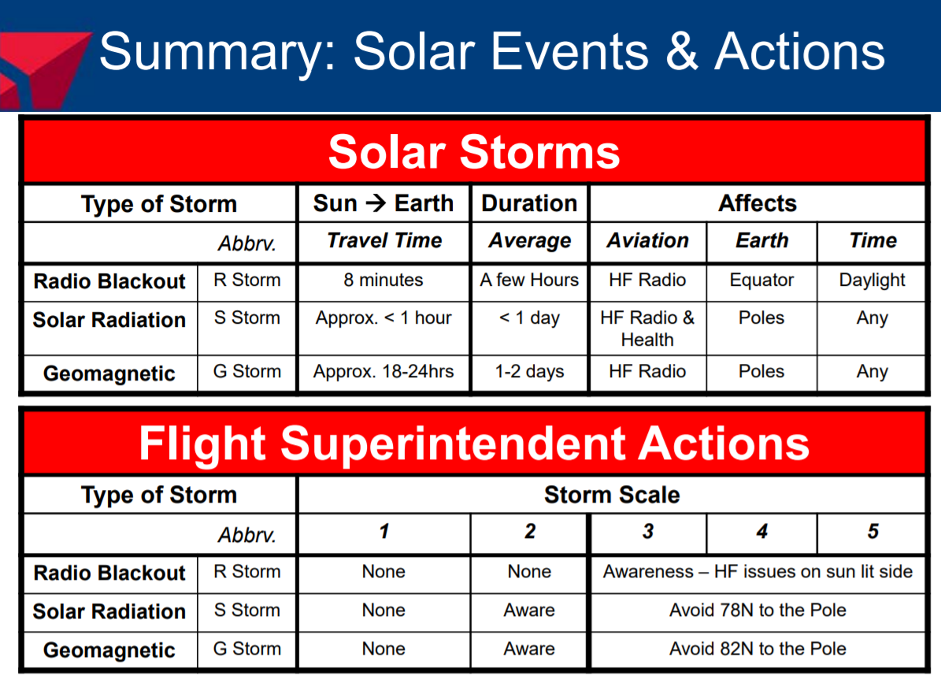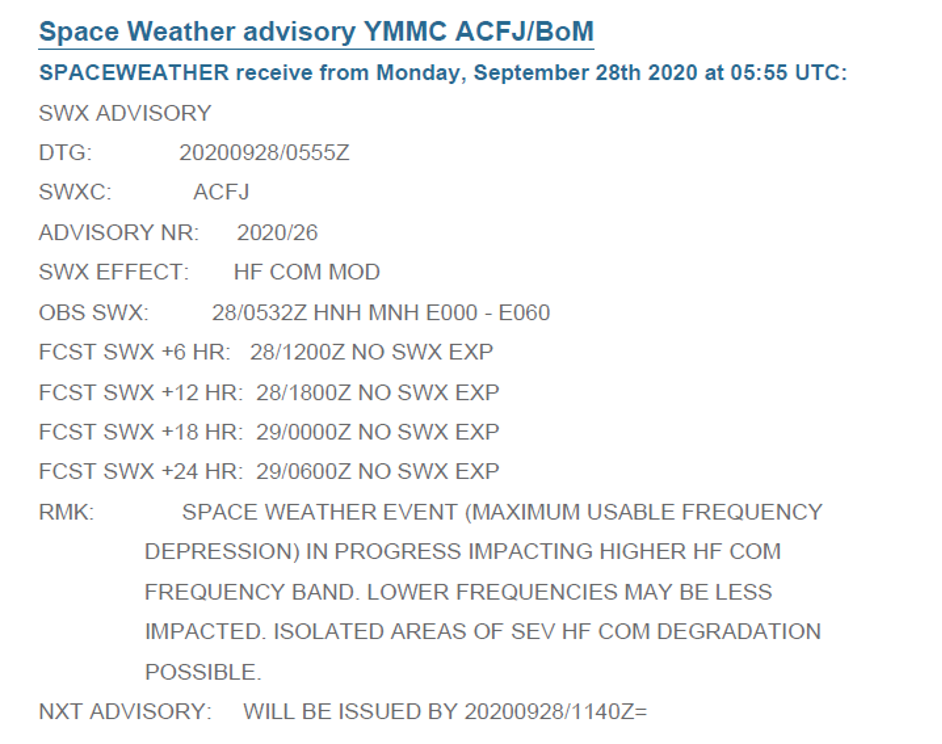

After a long process, a winding road to success, provisions for Space Weather Advisories were introduced, effective from November 2018. One year later, in November 2019, three Global Space Weather Centers have become operational and provide Space Weather (SWx) Advisories. On the 28th of September 2020 ICAO released their first-ever Space-Weather Advisory (see Links and Resources # 6).
The Space-WX Advisories using the existing channels, similar to SIGMET. The advisories are thereby transmitted directly to aircraft operators and flight crew throughout the flight as standard meteorological information (see here).
The advisories provide the most up to date information possible on any solar events and cover these three categories:
a) Shortwave Communications
b) GNSS
c) Increased solar radiation.
The ICAO Manual on Space Weather Information in Support of International Air Navigation (ICAO DOC 10100), describes the hazards of space-wx as follows:
1.3.1 Space weather impacts occur in communications, navigation, surveillance, radiation-sensitive electronics, and human exposure. Beyond the more generic indicators described in Section 1.2, the system impacts may include:
a) unexpected loss of communications;
1) HF voice and data link, i.e. controller pilot data link communications (CPDLC), on routes where
that manner of communications is used;
2) poor or unusable performance in satellite communications;
b) degraded performance of navigation and surveillance that rely on GNSS;
1) automatic dependent surveillance – broadcast (ADS-B) and/or automatic dependent surveillance – contract (ADS-C) anomalies;
2) sporadic loss-of-lock of GNSS, especially near the equator and post-sunset;
c) unanticipated non-standard performance of on-board electronics resulting in reboots and anomalies;
and
d) issues related to radiation exposure by aircrew and passengers.
There is almost no guidance material available regarding the practical use of these advisories. EASA has not transposed the ICAO text which introduced Space-Wx as of 2018 into its own material.
As a first step, some commonly used procedures for failures and the guidance available are put together to form a set of procedures that might be used to deal with Space Weather Advisories. Such procedures need to be included in the airlines´ operations manuals, to give both dispatchers and pilots a common understanding of how to handle SWx Advisories.

Some airlines have Space-Wx instructions already in their Manuals
With regards to GNSS, a look into the European GNSS Reversion Handbook for PBN Operations (Link # 4, below), Appendix 1, is recommended. It shows that GPS unavailability impacts / makes unusable the following aircraft systems, depending on installation: GPSreceiver / loss of position & time information to aircraft systems, FMC- degraded, reversion to DME/DME & IRS if possible
Other unusable systems GBAS, SBAS, Synthetic Vision, ADS-B, ADS-C, CPDLC (unusable due to unreliable time-stamp on messages), SATCOM, EGPWS (if no position-updates from IRS with radio updating).
It is possible that ACAS-X may also be unusable or degraded due to lack of ADS-B input.
Other degraded systems: ATC transponder downlink parameters, ACAS (RF reducing function, ACAS will work), ACARS: no position reporting, Attitude and Heading Reference System, ELT, Digital Flight Data Recorders
Bottom line, for pilots: Loss of GNSS affects the position and accurate time base, which impairs the navigation including ADS position reports, is quite a serious issue and needs to be treated with caution. The following procedures should be considered:
| SWx Advisory | Inflight / en-route | Dispatch / before departure |
|---|---|---|
| GNSS MOD |
Check means of navigation (dme-updating, IRS, VOR) Check RNAV/RNP-Capability and requirements Check if conventional approach procedures at destination and alternate can be used & plan accordingly |
check means of navigation (dme-updating, IRS, VOR), incl. MEL Check RNAV/RNP-Capability and requirements Check if conventional approach procedures at destination and alternate can be used & plan 2nd alternate Consider adding 30 min contingency fuel for unforeseen events, e.g. airspace closures |
| GNSS SEV |
Check means of navigation (dme-updating, IRS, VOR) Check if conventional approach procedures at destination and alternate can be used & plan accordingly Ensure availability of planned route / RNAV/RNP Consider diversion & landing at enroute airport |
Check means of navigation (dme-updating, IRS, VOR), incl. MEL Check if conventional approach procedures at destination and alternate can be used & plan 2nd alternate Check airspace and route availability (RNAV/RNP) Consider including 1hr contingency fuel for unforeseen events e.g. airspace-closures Consider flight cancellation |
Degradation or un-usability of shortwave radio communications can have serious consequences, especially if HF is the only communications medium. Air Traffic Control does simply not work without communications, and thus, the following is suggested:
| SWx Advisory | Inflight / en-route | Dispatch / before departure |
|---|---|---|
| HF MOD | Check conditions on all frequencies in the area, use best Use datalink or satcom voice if required |
Provide list of best HF frequencies Ensure satcom is available, no MEL exception no dispatch into areas where HF is prime means of communications Consider adding 30 min contingency fuel |
| HF SEV | Check conditions on all frequencies in the area, use best Use datalink or satcom voice if required If no VHF or satcom available and HF is only means of com: do not enter area of HF SEV conditions Follow com failure procedures until VHF contact is restored |
Do not dispatch into an area with obs or fcst HF SEV where HF is required for communications Consider adding 30 min contingency fuel |
When flying, it is normal to be exposed to radiation coming mostly from space and, to a lesser degree, from the sun. During rare periods, solar activity predominates, and increased radiation levels prevail. To follow the radiation protection principle of ´ALARA´, as low as reasonably achievable, and to help ensure that the radiation dose for the travelling public but also the crew stays within limits, the procedures below are suggested. Note that a reduction in flight altitude by 7000 ft may reduce the radiation dose by half. Details are available in the IFALPA Briefing leaflet (see Links and Resources # 2).
| Inflight / en-route | Dispatch / before departure | |
|---|---|---|
| RADIATION MOD |
Do not perform any planned step-climbs If above FL designated in RAD MOD message, request descent to 3000 ft below that FL using normal procedures |
Restrict max FL to 3000 ft below FL designated in RAD MOD msg. Apply until 12 hrs. after last message |
| RADIATION SEV |
If above FL designated in RAD SEV message, request descent to 3000 ft below that FL using normal procedures If no clearance available within 30 min., consider descent with 1000 - 1500 ft/min to 3000 ft below RAD SEV |
No dispatch into areas with RAD SEV Apply until 12 hrs. after last message |
Space-Weather is a complex phenomenon with potentially severe impacts on the safety of flight operations. Effective mitigation by the pilots requires the access to ICAO Space Weather advisories as well as appropriate instructions in the airlines´ Operations Manuals.
# 1, ICAO, Cross Polar Working Group 2019
https://bit.ly/3deDRYc
https://www.faa.gov/about/office_org/headquarters_offices/ato/service_units/mission_support/ato_intl/documents/cross_polar/CPWG27/CPWG27_ICAO_SWX_Advisory_Brief.pdf
# 2, IFALPA Human Performance Briefing Leaflet:
Aircrews and Ionizing Radiation
https://www.ifalpa.org/media/3467/19hupbl01-aircrews-and-ionizing-radiation.pdf
# 3, Australian Bureau of Meteorology, Space Weather Advisories
http://www.bom.gov.au/aviation/data/education/space-wx-advisories.pdf
# 4, European GNSS Contingency/ Reversion Handbook for PBN Operations
PBN HANDBOOK No. 6
https://www.eurocontrol.int/archive_download/all/node/12154
# 5, DELTA Airlines, Space Weather Workshop, 2017
https://www.swpc.noaa.gov/sites/default/files/images/u33/%281140%29%202017%20SpaceWx%20Workshop-Delta%20Presentation-03May15.pdf
# 6, ICAO first-ever Space-Weather Advisory (28th September 2020):
